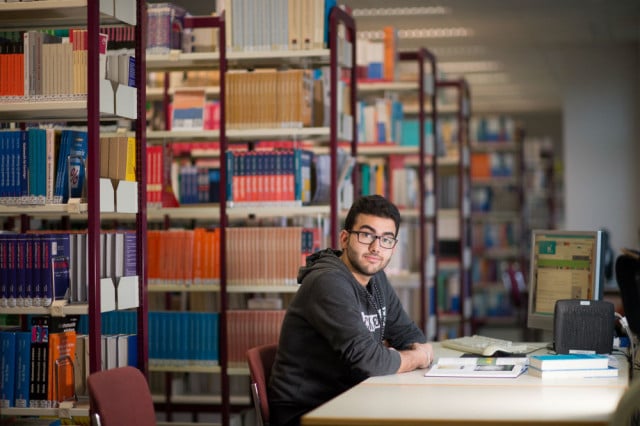Nearly 2,000 of the 18,000 post-secondary courses to choose from in Germany cater to international students in that they're conducted in the English language. 12 percent of the country's students come from abroad.
But in order to be able to pursue higher education here, you must have an Abitur (completion of final exams) or Fachhochschulreife (university of applied sciences entrance qualification). A comparable qualification is required for foreign students.
Provided you have this in hand, an abundance of study options are available to you. These are the three main types of higher education institutions in Germany.
1) Colleges of Art, Music and Film (Kunst-, Musik- und Filmhochschulen)
Despite being referred to as colleges, these schools in their respective art fields offer degrees upon completion of studies and have equivalent status to universities.
Studying at a Kunsthochschule generally encompasses learning in a practice-based setting about the fine arts and specializing in subjects such as painting, sculpture, photography or ceramics.
A portfolio of 15 to 40 small works of art may be required as part of an art college's application process, as is the completion of stringent entrance exams.
Students at Kunsthochschule Burg in Halle, Saxony-Anhalt, showcasing their work in July. Photo: DPA.
With regards to music colleges in Germany, of which there are about 30, an emphasis is placed on the making of music, though priority is also given to singing, conducting and sound production. Over one third of the students at Germany’s music colleges come from outside the country.
Filmhochschulen programmes focus on directing and filming skills, but also screenwriting, dealing with sound and music as well as image and digital editing.
Other post-secondary studies in the creative field, such as fashion and design, can be found across Germany in a variety of other institutions: universities, universities of applied sciences, and private academies.
2) Universities of Applied Sciences (Fachhochschulen)
The primary focus at Fachhochschulen is for students to apply scientific knowledge and to be taught professional practice in topical areas (business, technology, social affairs, media, etc.)
“Programmes at universities of applied sciences are usually more practice-oriented,” Hermann Reuke from the Central Evaluation and Accreditation Agency (ZEvA) in Hanover told Süddeutsche Zeitung (SZ).
READ ALSO: German universities among world's best for science subjects
Though the prerequisites to get into universities and universities of applied sciences are the same, Fachhochschulen are more likely to involve practical semesters which means the courses “are not six, but rather, seven or eight semesters long,” says Reuke.
And while bachelor’s and master’s degrees are offered at both Fachhochschulen and universities, depending on the institution, course groups are oftentimes smaller and more manageable at Fachhochschulen.
In Germany there are 106 universities and more than twice as many Fachhochschulen, according to Zeit Campus. But whereas an average of 16,500 students attend any one university in the country, 4,500 students attend a university of applied science.
“It is a very individual decision – whether to go to university or to a university of applied science,” freelance academic advisor Wolfgang Loggen told SZ, adding that universities more often deal with theoretical subjects.
If you are keen on studying humanities or linguistics, for instance, you are more likely to find these courses at universities, adds Loggen.
 Zain Akash studying in the library at the Fachhochschule Magdeburg. Photo: DPA.
Zain Akash studying in the library at the Fachhochschule Magdeburg. Photo: DPA.
Another German term which is widely used to speak about higher education is 'Hochschulen' – institutions which award academic degrees (e.g. colleges, universities and universities of applied sciences).
More and more Fachhochschulen in recent years have been shortening their names to Hochschulen. 'Fachhochschule Osnabrück' in North Rhine-Westphalia for example changed its name in 2010 to 'Hochschule Osnabrück'.
Most Hochschulen, such as the one in Bremen and the one in Ingolstadt, have international offices which seek to support foreign students in any way they can.
3) Universities (Universitäten)
Universities are more often than not strongly research-oriented and offer a wide range of courses. Here too, there are practical aspects, but the emphasis is on solid theoretical training and methodological expertise.
Some programmes can only be found at universities, such as classical law studies.
But a special type of German university where you’re less likely to find a programme in law is a technical university.
Technical universities (Technische Universitäten) focus on mostly engineering and natural science subjects.
Important to note as well is that universities and schools of equivalent status are the only institutions in Germany with the right to confer doctorates.
 Photo: DPA.
Photo: DPA.
Higher education institutions: public vs. private
The types of institutions listed above can be divided into two categories: state-run and private. While most German universities are publicly financed, there are 120 private universities and these consist mainly of Fachhochschulen.
Over 90 percent of students in the Bundesrepublik are enrolled at public universities and colleges; only about 5.5 percent attend a privately-funded one – likely due to private institutions charging high tuition fees.
Students at state-run universities in Germany – both local and international students – do not pay tuition fees, but rather, simple administrative fees of between €100 and €500 per semester that also cover their public transportation costs.
Vocational academies (Berufsakademie) are another example of a privately funded institution. But these schools, of which there are over three dozen across Germany specializing in programmes ranging form the social sciences to technology, are not technically regarded as higher education. This is despite the fact that some of their qualifications are recognized as comparable with those of Fachhochschulen.
SEE ALSO: These 10 German universities are best at landing you a job





 Please whitelist us to continue reading.
Please whitelist us to continue reading.